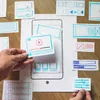How UI/UX can drive success for your business idea
User experience not just about aesthetics and good looks – it has got a lot to do with customer-centricity, and ease of navigation.

The boom in the smartphone market, coupled with widespread access to the internet has radically changed the way consumers interact with brands.
Just like one would judge a car by its design, a brand by its offline presence, and banks by their reputation, online businesses are primarily judged by the experiences they deliver and how easy they are to use.
In this age of ubiquitous technology, every website, app, and software product is fighting for the user’s attention, across all platforms, and users are infinitely spoilt for choice.
And due to the big players in the game (Whatsapp, Facebook, Instagram, TikTok, Chrome, ), users are surrounded by slick product interfaces and experiences.
These experiences have been curated after years of feedback, analytics, and research to ensure that the user understands everything intuitively, and has very little friction in completing the functionality available. Over time, this has reduced the average attention span and patience of the user.
According to a study by Microsoft, the average attention span of a user is now eight seconds. This is a sharp decrease from the average attention span of 12 seconds in the year 2000. If the product seems tough to understand or takes too long to use, there is a very high chance that the user will leave for a competitor with a better and/or quicker experience.
This is precisely why attention to UX is now absolutely crucial to businesses everywhere.
So what is UX??
UX stands for User Experience Design - which in layman terms is the design of how a product is used (rather than how it looks). The main aim is to make your product easy to understand, intuitive, and quick to use. But there is only so much you can get right, to begin with.
After product launch, a huge portion of time is spent identifying problems, implementing solutions, measuring impact, and continuously iterating till near perfection. Different consumers could use products in varied ways, simultaneously having pain points that one could never even imagine.
Identifying the problems is usually much tougher than solving them and could make a significant difference to the bottom of a brand’s conversion funnel.
While making a product user friendly, one cannot ignore the need for aesthetic appeal. Visually stimulating interactions can cause an emotional connection for a user, trigger endorphin rushes, and enhance the overall experience value associated with your product.
A stellar example of a great UX based feature implementation is Swiggy Pop. Swiggy identified a market of users that want to order cheap food - quickly. A specific restaurant or special food items didn’t matter as much as delivery time and price.
Swiggy Pop handles this use-case by giving a set choice of regular food items that represent a full meal, are cheap, are from nearby restaurants, and don't have a delivery charge. The fact that food items are always set lets restaurants keep food prepared which reduces cooking time, and so reduces the overall delivery time.
Additionally, the entire experience of ordering is extremely optimised, auto-populating options wherever possible, and ensuring that you could order a meal in four clicks - choose food, confirm order (payment terms, address), Enter OTP, done. Before you know it, the food is on its way. I switched from Zomato to Swiggy just because of such experiences.
Another great example of hugely differentiating UX is the Apple suite of products. Even though Apple products are very price-heavy, their product experiences make users loyal beyond the point of reason (with regards to price). And their ecosystem of products all link beautifully with each other, providing a seamless journey across the different devices.
A user can answer phone calls on the Apple Watch or the MacBook, iCloud syncs data and apps across devices, Airdrop helps transfer files across the iPhone, iPad, and Mac with unparalleled speed and ease. You can even copy text on one device and paste it on the other with no delay!
In conclusion, UX is not just about aesthetics and good looks, it has got a lot to do with customer-centricity, ease of navigation, and complete end-to-end experience that the customer gets on your app or website.
These factors determine whether your business is going to get people knocking at your door time and again.
Unless user experience is ingrained into your company’s DNA and every single member of your team is working towards it, you will always fall short of being on top of the ladder.
Edited by Aparajita Saxena
(Disclaimer: The views and opinions expressed in this article are those of the author and do not necessarily reflect the views of YourStory.)









